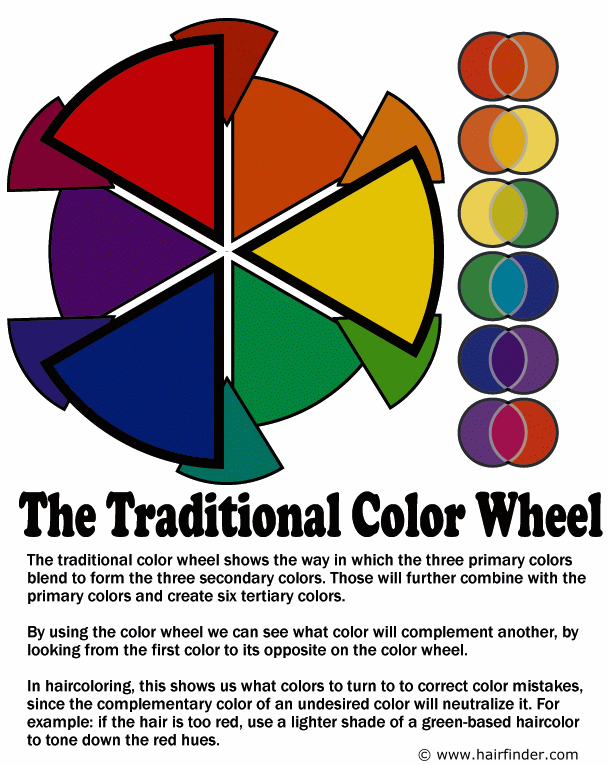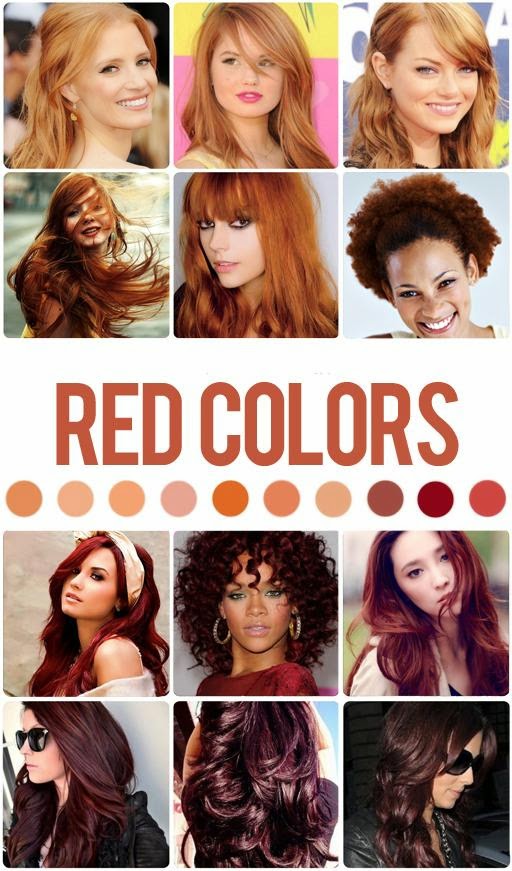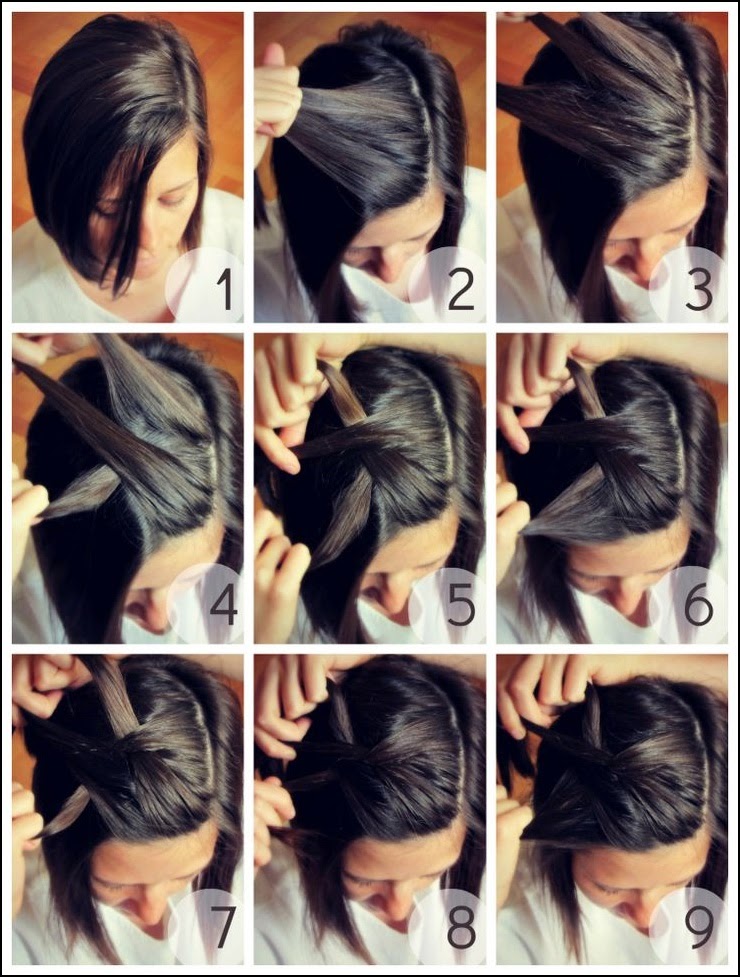How To Use The Hair Color Wheel

Do you know that there is a Law of Hair Color? Laws?, you say. Hair color is an art. What is all this talk about laws? I’ve heard many hair stylists over the years as I’ve taught color classes say things like, “I am a hands-on person. I like to see it. I don’t care about the theory part, let’s just do it.”So, what are laws? Why are they so important and why do I want to get you excited about learning them? There are natural laws that apply to everybody everywhere. No matter where you live or who you are these laws will apply. Laws are simple and obvious truths about a circumstance beyond one’s control that never require a second guess, or an experiment, to verify them. When you know the law of something, you always know the outcome.
For example, what happens when you drop your shears or your comb? They will fall down. They will never fly upward or take a spin around the room. They will always fall down. Do you see where I am beginning to go with this? The laws of hair color (and cutting for that matter) are important and often very neglected. It’s imperative that all professional hair stylists know why we do what we do. Why do you choose the color you do to use on your client?.
The information here is designed to assist the artist in understanding hair color. It will help you understand the laws of color when applying them to what you do in your salon everyday. It will make you an informed professional – a cut above the rest.
Do you remember the triangular prisms in high school making rainbows with white light? Each color has its own wavelength. Red is the longest wavelength and violet has the shortest. White is all the colors together and black is the absent of color. Now what we have to understand is that some of these wavelengths are absorbed and others are transmitted. For example, red hair color absorbs all the light rays except the warm ones. The warm ones are transmitted. This is the natural law of why red hair looks red.
There are three essential traits of color. The name of a color is called a hue: like red, yellow, blue. The percentage of the hue is called saturation. Pink is a good example of a low percentage (saturation) of red. Tone is the lightness or darkness of a color. For example, pink has a lighter tone than red.
Traditional color wheel The purpose of the color wheel is to clearly illustrate the way in which the colors relate to one another. When colors are opposite one another on the color wheel they are Complementary Colors. Complementary colors placed side by side will intensify the appearance of both colors, yet when any two complementary colors are combined in the proper proportion (as when applying hair color for color correction), they neutralize one another.
When we look at hair color, the values of the traditional color wheel are too limited to explain the scope of the color available. To more-accurately represent the color, we need to add in the dimension of light-level as part of the color wheel. The lightness level of a haircolor is important in its classification in the three basic groups: Blonde, Brunette, and Redhead.
Our Hair Color Wheel utilizes the standard Primary and Secondary colors, as well as their Tertiary combinations, but these base colors are overlaid on a gradient scale (from one to ten) of lightness levels. One is absolute darkest (black), and ten is palest blonde. The base colors present overlaying the lightness levels help to demonstrate how to differentiate the myriad haircolors available.
There are three primary colors: blue, red, and yellow. They are called primary because all other colors are made from them.
The secondary colors are violet, orange, and green. Blue + Red = Violet, Red + Yellow = Orange, and Yellow + Blue = Green
Tertiary colors are made by mixing the primary and secondary colors together. There are six possible combinations. They are yellow-orange, red-orange, red-violet, blue-violet, blue-green, and yellow-green.
Two colors are called complimentary colors if when mixed together they produce a neutral color. (grey, white or black) They are located opposite from each other on the color wheel. When you mix any color with their complimentary color, you will produce a neutral or browned-out color.
The color wheel is also separated into warm and cool colors. Blue (a primary color) is the coolest cool color and is also the darkest. It generally lives at a level three. (More on levels to come.) You will need to remember this as the more blue that is added to your hair color, it will produce a darker, cooler tone. Red or yellow (also primaries) are warm colors. Adding red to your hair color formula will create a warmer tone. Just as blue is the darkest cool toned color, yellow is the lightest warm toned color. Adding yellow to your color formula will always produce a lighter, brighter color.
Seeing how the colors lay out along the wheel helps to show you their relationships and gives advice on how to deal with problems that may arise – as well as avoiding those problems to start. When choosing a color it can be best to stick with analogous color bases to your starting shade.
If you want to go a different direction with the color of your hair – say if you are a redhead and want to tone down the hue of your red mane, then you could perhaps use the color wheel to find a color on the opposite side of the spectrum and apply it to tone down the color. In the case of a redhead such as Dark Spice Brown, you could use a Medium Ash Blonde, or even a Medium Cool Brown to neutralize some of the red color. Just be aware that applying a dark level color on top of a dark level color will only result in increased darkness of the color, regardless of the base color.
A colorist should not only memorize but thoroughly understand the color wheel. It is a tool that will be used almost every time you color a client’s hair. It will help you create colors with greater accuracy. So to recap, the color wheel is arranged so that contrasting colors are placed directly across from their opposite. This is very important since it is necessary to know which colors can be used to “neutralize” or “brown-out” undesired tones. For instance, a common issue for stylists is eliminating unwanted orange and yellow tones in the hair. When you know and understand the color wheel and can see that violet is the opposite of yellow on the color wheel, you can then choose a violet pigment in order to neutralize the yellow. If the unwanted color is orange, you can see that blue is the color to use to neutralize the unwanted tone.
On the other hand, the color wheel is also used to correct best hair color that has taken on “ashy” tones, such as green, blue, or violet. The color wheel shows that in order to neutralize green, red must be applied to the hair. Remember, opposites on the color wheel get rid of unwanted tones and have a neutralizing effect!
We all would say we can spot a blonde, but there is a specific designation of the crossover point from blonde to brunette. Colors that are level five and above (to level ten) are classified as blondes (unless they are in the red family). Thus blondes can be cool, such as platinum blondes, and ash blondes, or they can be warm, such as with golden blondes.
Brunettes usually begin as we darken to level six and darker – all the way to black. The base tones of these shades can be warm (such as caramel tones or honeyed browns) or cool (as with ash brown and blue black).
Redheads generally are found in the warm spectrum of the color wheel, but can be virtually any level of lightness - every shade from Strawberry Blonde, down to Dark Spice Brown. Redheads can be bold and brassy copper-tops like Lucille Ball, or Carol Brunette, or more sedate celebrity redheads like country music singer Naomi Judd, and her actress-daughter Ashley Judd who has dark auburn hair.
It’s going to depend on how faded your current color is and what dye you used.
Most fashion color dyes are easy to dye over, without having to bleach if you use the color wheel and a good quality fashion dye.
If you used Splat! though, you are going to have a lot more work to remove it enough to be able to dye it any other color, including black, without some of the old color bleeding through
Learn the universal or natural laws of hair color, you will be empowered to create and recreate any look you want!.
For example, what happens when you drop your shears or your comb? They will fall down. They will never fly upward or take a spin around the room. They will always fall down. Do you see where I am beginning to go with this? The laws of hair color (and cutting for that matter) are important and often very neglected. It’s imperative that all professional hair stylists know why we do what we do. Why do you choose the color you do to use on your client?.
- What is color?
- Essentials of Color
- The Relationships of Colors
The information here is designed to assist the artist in understanding hair color. It will help you understand the laws of color when applying them to what you do in your salon everyday. It will make you an informed professional – a cut above the rest.
What is color?
The soul becomes dyed with the color of its thoughts.Color is light and pigment. When we color someone’s hair we can emphasize their skin tone and eye color, we can make their hair look fuller, add texture and even help them express their personality. The laws of hair coloring apply to light and pigment. When we understand these laws, we will never have to guess and our results will always be expected.White Light
Do you remember the triangular prisms in high school making rainbows with white light? Each color has its own wavelength. Red is the longest wavelength and violet has the shortest. White is all the colors together and black is the absent of color. Now what we have to understand is that some of these wavelengths are absorbed and others are transmitted. For example, red hair color absorbs all the light rays except the warm ones. The warm ones are transmitted. This is the natural law of why red hair looks red.
Essentials of Color
There are three essential traits of color. The name of a color is called a hue: like red, yellow, blue. The percentage of the hue is called saturation. Pink is a good example of a low percentage (saturation) of red. Tone is the lightness or darkness of a color. For example, pink has a lighter tone than red.
The Relationships of Colors
Traditional color wheel The purpose of the color wheel is to clearly illustrate the way in which the colors relate to one another. When colors are opposite one another on the color wheel they are Complementary Colors. Complementary colors placed side by side will intensify the appearance of both colors, yet when any two complementary colors are combined in the proper proportion (as when applying hair color for color correction), they neutralize one another.
 |
| Traditional color wheel |
The Color Wheel as it Pertains to Hair
Our Hair Color Wheel utilizes the standard Primary and Secondary colors, as well as their Tertiary combinations, but these base colors are overlaid on a gradient scale (from one to ten) of lightness levels. One is absolute darkest (black), and ten is palest blonde. The base colors present overlaying the lightness levels help to demonstrate how to differentiate the myriad haircolors available.
The Color Wheel
There are three primary colors: blue, red, and yellow. They are called primary because all other colors are made from them.
The secondary colors are violet, orange, and green. Blue + Red = Violet, Red + Yellow = Orange, and Yellow + Blue = Green
Tertiary colors are made by mixing the primary and secondary colors together. There are six possible combinations. They are yellow-orange, red-orange, red-violet, blue-violet, blue-green, and yellow-green.
Two colors are called complimentary colors if when mixed together they produce a neutral color. (grey, white or black) They are located opposite from each other on the color wheel. When you mix any color with their complimentary color, you will produce a neutral or browned-out color.
Coolness and Warmth
The color wheel is also separated into warm and cool colors. Blue (a primary color) is the coolest cool color and is also the darkest. It generally lives at a level three. (More on levels to come.) You will need to remember this as the more blue that is added to your hair color, it will produce a darker, cooler tone. Red or yellow (also primaries) are warm colors. Adding red to your hair color formula will create a warmer tone. Just as blue is the darkest cool toned color, yellow is the lightest warm toned color. Adding yellow to your color formula will always produce a lighter, brighter color.
How to Use the Hair Color Wheel
If you want to go a different direction with the color of your hair – say if you are a redhead and want to tone down the hue of your red mane, then you could perhaps use the color wheel to find a color on the opposite side of the spectrum and apply it to tone down the color. In the case of a redhead such as Dark Spice Brown, you could use a Medium Ash Blonde, or even a Medium Cool Brown to neutralize some of the red color. Just be aware that applying a dark level color on top of a dark level color will only result in increased darkness of the color, regardless of the base color.
A colorist should not only memorize but thoroughly understand the color wheel. It is a tool that will be used almost every time you color a client’s hair. It will help you create colors with greater accuracy. So to recap, the color wheel is arranged so that contrasting colors are placed directly across from their opposite. This is very important since it is necessary to know which colors can be used to “neutralize” or “brown-out” undesired tones. For instance, a common issue for stylists is eliminating unwanted orange and yellow tones in the hair. When you know and understand the color wheel and can see that violet is the opposite of yellow on the color wheel, you can then choose a violet pigment in order to neutralize the yellow. If the unwanted color is orange, you can see that blue is the color to use to neutralize the unwanted tone.
On the other hand, the color wheel is also used to correct best hair color that has taken on “ashy” tones, such as green, blue, or violet. The color wheel shows that in order to neutralize green, red must be applied to the hair. Remember, opposites on the color wheel get rid of unwanted tones and have a neutralizing effect!
Blondes, Brunettes and Redheads
We all would say we can spot a blonde, but there is a specific designation of the crossover point from blonde to brunette. Colors that are level five and above (to level ten) are classified as blondes (unless they are in the red family). Thus blondes can be cool, such as platinum blondes, and ash blondes, or they can be warm, such as with golden blondes.
Brunettes usually begin as we darken to level six and darker – all the way to black. The base tones of these shades can be warm (such as caramel tones or honeyed browns) or cool (as with ash brown and blue black).
Redheads generally are found in the warm spectrum of the color wheel, but can be virtually any level of lightness - every shade from Strawberry Blonde, down to Dark Spice Brown. Redheads can be bold and brassy copper-tops like Lucille Ball, or Carol Brunette, or more sedate celebrity redheads like country music singer Naomi Judd, and her actress-daughter Ashley Judd who has dark auburn hair.
Special Challenges in Haircolor/Corrective Solutions/Haircolor Tips for Redheads/Brunettes/Blonds
- To create warm coppery reds, use a red-orange base color.
- To create hot fiery reds, use red-violet or true red colors.
- Brunettes:
- Use a cool blue base to avoid orange or brassy tones.
- Blonds:
- Double-process bonding is the best way to obtain pale blond results.
It’s going to depend on how faded your current color is and what dye you used.
Most fashion color dyes are easy to dye over, without having to bleach if you use the color wheel and a good quality fashion dye.
If you used Splat! though, you are going to have a lot more work to remove it enough to be able to dye it any other color, including black, without some of the old color bleeding through









Comments
Post a Comment
HairFashionOnline Comment Policy
We welcome relevant and respectful comments. Comments with Promotional hidden links may be removed.
Please read our Comment Policy before commenting.